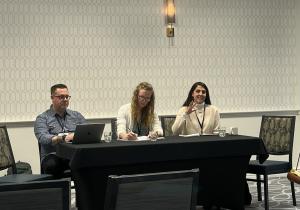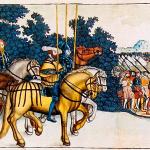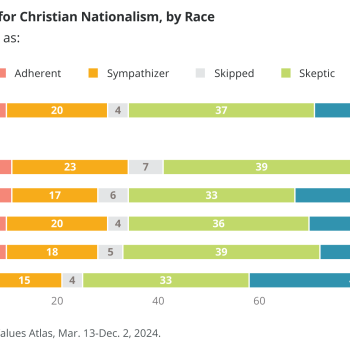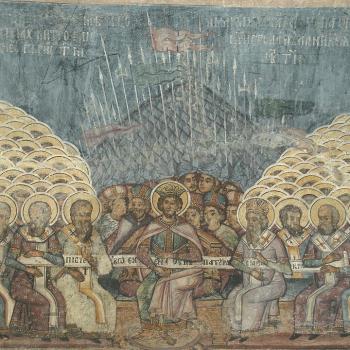Last month, many historians of religion gathered in San Francisco for the American Society of Church History’s annual conference. It was a wonderful time to engage with new work and ideas as well as connect with fellow scholars and friends, including several fellow Anxious Benchers. If you’ll indulge me, a review here of some of the panels—as well as a major question that emerged throughout the discussions.
For me, the conference began on Friday morning, as I got to participate in a panel, “Black Christian Radicalism after the Civil Rights Era” with the delightful and brilliant Robert O. Smith of the University of North Texas and Karen Johnson from Wheaton College (Taurean Webb, our chair and commenter had to miss, sadly.) Smith, (along with his partner, Aja Martinez) respond to current screeds decrying Critical Race Theory (CRT as “Marxist” by looking at the actual archives of founder Derrick Bell. What they have found, and what Smith captivatingly explained, were Bell’s deeply Christian commitments, both theological and communal, in his work. Bell’s ideas about evil and systems and justice and hope were informed by the Black Church; so were his patterns of living: his long marriage to Jewel, frequent Bible studies, and living room fellowship and worship sessions. Ignoring Bell’s Christianity is not only to miss the influence of the Black Church in legal theory, but also to expose the smear campaign against CRT for what it is: an uniformed, ahistorical campaign.
I spoke a bit about Charles and Shirley Sherrod and the Christian radicalism of New Communities, the Black-owned collective farm in Lee County, GA from 1968-1985, before turning it over to Karen Johnson. With characteristic historical care, Karen wrestled aloud with Perkins and his legacies, exploring a trajectory that runs counter to prevailing historiographical patterns: from Black Power to “reconciliatory” accommodationism, what Perkins will even call colorblindness. Johnson admittedly admires the admirable Perkins but also follows his intellectual and spiritual developments from a position of Black radicalism in the Movement that advocated public services and collective care in Mendenhall, to one that by the 1990s diminished the significance of skin color at all, in favor of a personal politics of individual transformation. Perkins change mirrors much of American political thought across the late 20th century, but his life complicates the story in interesting ways.
One of these, and a theme of our panel, was the role of friends, mentors, co-travelers and backers. Derrick Bell spent a lot of time with his wife, his pastor, with Constance Baker Motley. Charles Sherrod with Shirley and poor Black people in Southwest Georgia, and a little with white liberal benefactors and ambitious Zionists. As for Perkins, he ended up spending a lot of time with Mississippi white Christians, with leaders of Christian colleges, with integrationists from CCDA. Perhaps that, as much as anything, affected his move away from Black Power? Robert then introduced us to a wonderful concept in writing biography of imagining constellations of connections and relationships, through which ideas, money, emotions connect various people and entities. All biographers do this to some extent, but rather than privileging this notion of Bell’s thought, or Sherrod’s activism, or Perkins’ work as an individual, singular effort, we came to see that all are better understood in the context of interconnected people and ideas and movements. These networks—that either sustain or diminish, radicalize or neuter– are really the more interesting story.

That afternoon, I caught another amazing panel (though not a seat; we posted up on the floor in the back). The packed house listened to Rachel Wheeler, Emily Conroy-Krutz, Alexis Wells-Oghoghomeh and Kate Carte reading for Michael Baysa discuss Kathryn Gin Lum’s recent book Heathen, which was continually described as “magisterial.” Wonderful comments all around—about lumping and clumping, about the limits of conversion and anti-Blackness, about language and art and cartography and close reading. Another notable panel the next morning, “Contested Evangelical Traditions,” featured robust conversations around Jon Garcia’s work on Mexican Fundamentalism, Aaron Ross’ on Indigenous Pentecostalism, and Austin Steelman’s on white evangelical legal arguments in the Brown period. These vivid papers challenged simplistic narratives and reveal contested outcomes and decisions how about how to practice faith. “Modern Prescriptions: Seeing Medicine through Religion” featured a fantastic panel of scholars, Christina Ramos, Jonathan Riddle, and Judith Weisenfeld, who together explored extra-ecclesial spaces for religious work, conversion, and language. Hospitals, veganism, cold baths, asylums for the Black religious: it was a wild and convincing and engrossing panel of excellent scholars, who are expanding our understanding of American religions and how they are made. I came away from all of them encouraged by the work of friends and colleagues, and stimulated for more thinking and talking, which happened over numerous coffee breaks, and will no doubt continue.
The talking really is the thing, too. So many brilliant, kind, old and new, friends. We talked about the panels, we talked about our lives and careers. Some were serious—what is the state of these denominations? Or these purity tests for colleges?—and others were so funny that I spewed water all over my co-conversationalists (Daniel, Jonathan: I’m still so sorry about that.)
But one question did emerge from the conference that I’ll just pose here in closing. During the Heathen Roundtable, Rachel Wheeler shared a personal archival discovery. A friend of her aunts, who she describes as “Boston Brahmin” had written them a scathing letter, critiquing their impulse, common among her race and class and gender, to help. While certainly well-intentioned, the writer explained, the outcomes were rarely good. Better to leave it alone since most missional or charitable efforts became, in her unflinching words, “death to those they are trying to help.”
But then, Jonathan Ebel, in his passionate and compassionate plenary, made the opposite case. Using the imperfect efforts to improve housing conditions amongst migrant workers in San Francisco in the 1930s and the oblivious meetings of the ASCH at the same time as an extended case study, Ebel urged action. Yes, he allowed, there will be mistakes and missteps; there will be unintended consequences. But the times call for action as well as critique and contemplation. Or, as he put it, hindsight and foresight. This was not a call for what’s sometimes called presentism, not a move away from dry old history topics toward those more applicable to the moment, but rather an imploring to work for good while we do our work. (Anyone have a copy of this address?)
Within the conference, then, these two divergent perspectives on the possibilities of doing good surfaced: Knowing what we know—about material interests and empire, white supremacy and Christian dominionism, must our doings be hopelessly deadly? Or should we accept the limitations, the correct coming critiques of historians, and still try to do some good while we can? Thoughts?













